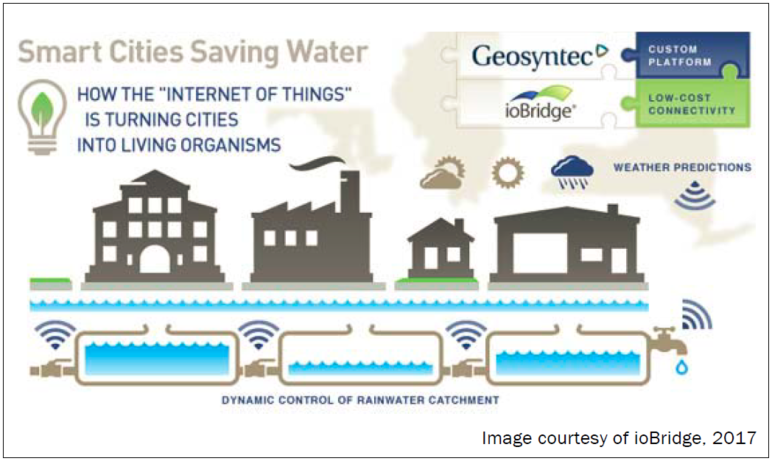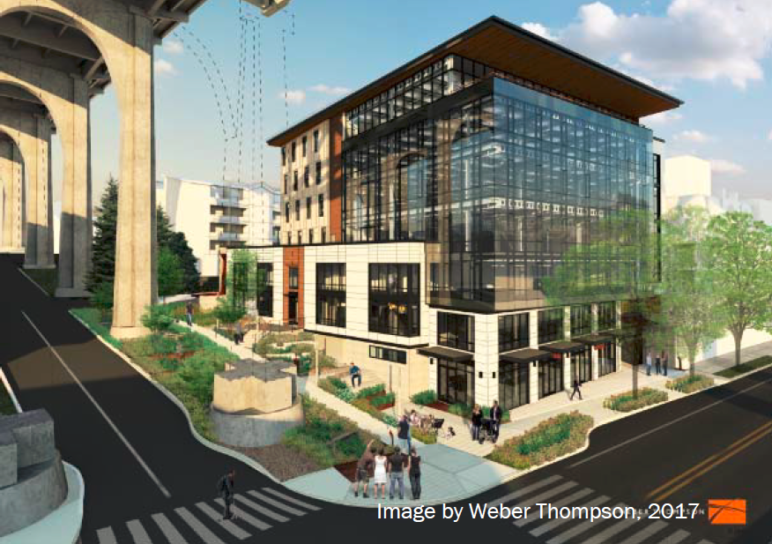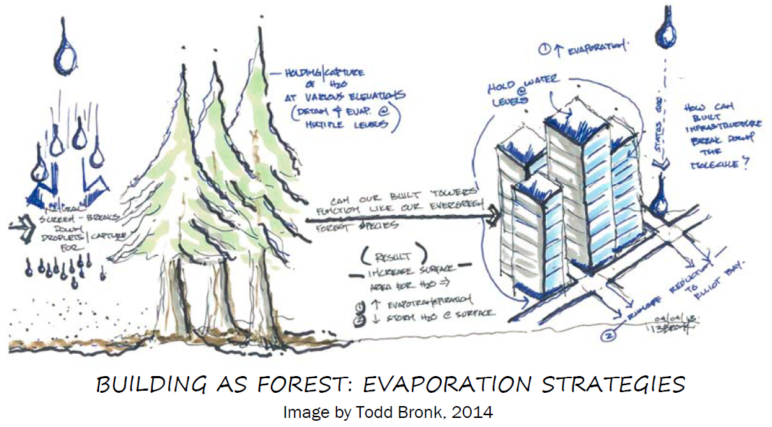Take a moment to recall your last hike through a Pacific Northwest forest. Maybe close your eyes, listen for the quiet of such lush flora around you, and breathe in the evergreen scent.
If you’re really imaginative, and if your hike was recent, you might also recall the rain. Perhaps you see drops suspended from pine needles, or you feel the buoyancy of the leaf litter below your feet. What you don’t remember, likely, is seeing gushers of stormwater runoff, like you might in a city.
That’s because Earth’s biosphere has about 3.8 billion years of design experience at managing its rainfall. Compared with the typically impervious urban environment, where about 80 percent of rainfall becomes runoff, in a healthy Northwest forest, just 0.2 percent of rainfall does.
A new report from the Urban Greenprint project looks to capitalize on that natural expertise, employing principles of biomimicry to improve how we build our cities. “Seedkit: Design Concepts Learned from Pacific Northwest Forests” identifies properties of forests that cities and towns can imitate to manage the massive quantities of rainfall for which western Cascadia is known.
Here, we summarize the report’s nine components, including the purposes they serve in the forest and the potential to mimic those functions—and their feel—in our built environment. The full report has more, such as questions about materials and product development and images of design concepts.

1. The obstacle course of a layered forest
If you think back to that hike, chances are you imagined a mix of taller and shorter trees, tiers of leaves and flowers, lichen and ferns and moss, and fallen wood, fungi, and other matter underfoot. Together, these make up a multi-layered canopy that, when it rains, helps to break up, slow, and hold water, as well as shield sunlight. From these dispersed drops and small pools, the water has a better chance of evaporating before it even hits the ground, reducing the absorption load of the earth by 10-20 percent in a typical Northwest forest.
How could we mimic that in the urban environment, so that less rain even reaches the pavement? A series of angled rain- and sun-screens is one idea to slow the flow of rainwater down the surfaces of our buildings. They could include mesh materials that separate and hold the rain in more evaporation-prone droplets. Below these, landscaping like planters and bioswales could catch the remaining trickle.


2. The sponge service of textured flora
The vegetation of a Cascadian forest works as a living sponge. From the canopy to the forest floor, different surface textures hold water in greater and lesser quantities, again facilitating evaporation.
Designers could incorporate such texturing into their buildings in many ways, some playful, some sleek. Living walls, meandering downspouts, and sculpted or vegetated gutters slow or even make use of stormwater running down a building—and they look beautiful to boot.


3. Evergreen needles’ drop-by-drop interceptions
There’s magic to the way a conifer looks after a rainstorm, each needle suspending at its tip an ornamental drop. Of course, this splitting, splashing, and holding is yet another means for the forest to intercept and evaporate more rainfall.
How might an urban space mimic this intricate arrangement? Wire sculptures, awnings, and screens hold a variety of answers and can adorn buildings from rooftop to ground.


4. Conifer cones: water-smart seed pods
No Northwest forest picture is complete without pine cones. To release their seeds at the best time, conifer cones respond to moisture levels in the air, closing when wet and opening when dry. (Fun fact: Pine cones can serve as an indicator of forest fire potential. If the cones on a forest floor are all open, it means fire danger is high.)
Some buildings already incorporate similarly dynamic elements, such as sunlight-responsive facades and wind-responsive canopies. Could they also get smart to water and humidity in the environment, helping to slow or capture rainfall when it is present?



5. Leaves: Micro-lungs flapping in the breeze
Transpiration—did that word just send you back to a middle school science class? As a refresher, transpiration is the process of water movement through a plant: in through the roots and out through other plant parts. Ninety-five percent of transpiration occurs through the pore-like stomata on plants’ leaves or needles.
What might transpiration look like in the built environment? It could be as simple as flapping fabric: banners, flags, canopies, or fabric-wrapped walls. An absorbent and loosely attached bolt of fabric could divert gallons upon gallons of water from drainage systems, returning that moisture to the air once wind and sun return post-shower.


6. Bark’s textured wrapper
The nooks and crannies of tree bark, grown and fissured over decades or centuries, provide countless spaces to slow or store rainwater and increase evaporation. Though building facades can’t actively grow, they could feature some bark-like texturing in their material: stamped metal or ceramic panels, textured cladding, and poplar bark are all available to builders already, and designers could develop new “bark” options.


7. Moss: An absorbent rain-screen
A Pacific Northwest resident likely would not be surprised to learn that there are over 12,000 species of moss. Moss’s water content typically matches that of its surrounding atmosphere, and its leaves are concave to collect and hold water. Moss lacks “true roots,” so it can grow nearly anywhere. And the undersides of moss repel water so they can be used for photosynthesis.
Porous building materials, living walls, wood rain-screens, and newer synthetic materials could serve as absorbent rain-screens, to soak up and hold rainwater. Replaceable, breathable, and attached directly to buildings, such materials release moisture through evaporation after the clouds blow away.



8. Mycorrhizae: Smart networks for sharing
Mycorrhizae are the symbiotic webs connecting fungi and plants. They serve as a sort of natural internet to collect and pass along information and to distribute nutrients among organisms.
While many cities already employ smart systems to manage energy or monitor water leaks or usage levels, they could step up their game. Imagine dynamic systems that, say, monitored and responded to changing weather systems, opening valves to redirect stormwater or rescheduling irrigation based on a rain forecast. A smart, connected water management system would disburse resources exactly as needed.



9. The forest’s holistic success
The specific Northwest forest elements listed above, in combination with countless others, weave a balanced water cycle because they operate together in a holistic system. If designers approached buildings with the same model in mind, they could blend multiple strategies to emulate natural processes.
The Watershed office building going up in Seattle’s Fremont neighborhood has in fact done just that, anticipating it will reuse or treat fully a half-million gallons of rainwater annually on its corner, just under the Aurora Bridge and mere blocks from Lake Union. Firms Rushing and 55-5 Consulting worked with Weber Thompson designers to explore several of the strategies listed above. For example, the team looked at whether the façade could include multiple downspouts, evaporative porous fins, absorptive moss beds, and percolating gutters. (This exercise also led to a competition submission as well with Eleven Magazine. The winner has yet to be selected, but the team is hopeful.) Although not all of the strategies explored were integrated into the final design, this project has been an example of a dramatically altered design process which could be carried through the industry to further improve the way water is handled by the build environment of Seattle.


A sylvan city future
Urban dwellers across Cascadia are debating what they want their changing cities to look and feel like, how they will manage worsening housing shortages, and how these urban centers will remain thriving and diverse centers of culture and opportunity.
If we looked to our much lauded natural surroundings for inspiration, Cascadians could learn a great deal about how to build better cities. Biomimicry holds promising techniques to inform how we manage everything from stormwater to energy use, improving overall performance and efficiency—and perhaps even aesthetic, giving the urban street scene a little more of that special feeling Cascadians treasure when out amidst our region’s rich and complex forests.
Alexandra Ramsden and Jennifer Barnes are guest contributors to Sightline Institute. They will be presenting this week as part of the 11th annual Living Future unConference. Learn more here.


Comments are closed.